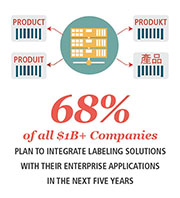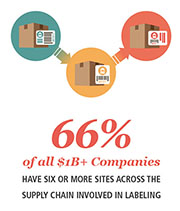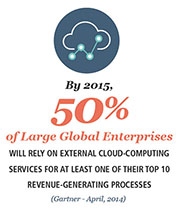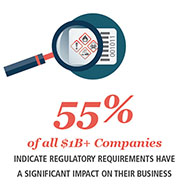Enterprise Labeling | Top 5 Trends in 2015
- Published: May 21, 2015, By Josh Roffman, Loftware
A recent survey of 500+ supply chain professionals has identified these five trends in labeling processes.
Today, there are a variety of factors impacting supply chain strategy and ultimately labeling processes. Therefore, it’s important to take a close look at what changes are driving today’s trends in labeling, which has become a mission-critical component in the supply chain as businesses continue to expand globally.
Growing customer demands and evolving regulatory requirements are just a couple of the trends that have been identified based on input from more than 500 supply chain professionals, from a wide range of leading global companies, in a recent Enterprise Labeling Trends Survey.
1. BUSINESSES ARE STANDARDIZING LABELING FOR CONSISTENCY & EFFICIENCY
 As business continues to expand globally, companies are recognizing the benefits of standardizing their labeling across global supply chains. Standardizing enables labeling consistency and dramatically streamlines maintenance and oversight, while offering the control to make rapid label changes throughout the supply chain. This standardized approach also helps global companies ensure business continuity in the face of disaster and empowers them to meet complex, global, and high volume labeling demands.
As business continues to expand globally, companies are recognizing the benefits of standardizing their labeling across global supply chains. Standardizing enables labeling consistency and dramatically streamlines maintenance and oversight, while offering the control to make rapid label changes throughout the supply chain. This standardized approach also helps global companies ensure business continuity in the face of disaster and empowers them to meet complex, global, and high volume labeling demands.
There are three important drivers behind the push to standardize:
- Providing Simplified Maintenance and Deployment: Offering the ability to centralize and deploy a standard labeling solution provides a wide range of benefits. Rather than manage multiple different systems, this standardized approach enables companies to streamline maintenance while supporting enterprise-wide labeling changes. In addition to reducing cost and simplifying maintenance, having a single, scalable solution facilitates expansion to new global locations.
- Ensuring Labeling Consistency: As businesses extend their reach across the global supply chain, it’s critical they maintain labeling consistency across multiple markets and regions. By taking a standardized approach, companies can ensure that a common set of labels, centralized applications and data sources are used across the supply chain. Also, ensuring consistency helps support compliance with brand standards that can rely on labels to help businesses differentiate their products, build relationships, and maintain customer’s trust regardless of where in the world labels are printed.
- Supporting Business Continuity: Both natural and man-made disasters can have a significant impact on a company’s supply chain and ultimately result in substantial financial consequences. Just as companies might shift production from one facility to another, a standardized approach to labeling allows them to rapidly shift label production in the same manner. By standardizing on a central labeling solution, companies can leverage the data and labels needed to keep the supply chain flowing and minimize the impact during a disruption.
2. INTEGRATED, DYNAMIC LABELING IS ESSENTIAL
 Today’s labeling needs to be both dynamic and data-driven to meet evolving customer and regulatory standards. Customers’ labeling requirements are more demanding and variable than ever, and businesses failing to meet those requirements in a timely fashion find themselves with dissatisfied customers that are likely to turn to competitors.
Today’s labeling needs to be both dynamic and data-driven to meet evolving customer and regulatory standards. Customers’ labeling requirements are more demanding and variable than ever, and businesses failing to meet those requirements in a timely fashion find themselves with dissatisfied customers that are likely to turn to competitors.
However, certified integration to the sources of truth for label data allows companies to automate labeling processes directly from enterprise applications while ensuring label data accuracy. This approach reduces the need to maintain countless permutations of labels, enabling configurable business logic to trigger labeling and empower companies to quickly respond to evolving regulatory, language, regional, business, and customer specific requirements.
Customer responsiveness in labeling typically centers on meeting the following expectations:
- Integration with Business Systems is Imperative: Integration models that support the seamless exchange of data and eliminate the need for manual processes allow companies to maintain their existing systems and user interactions, while automating their labeling processes and improving overall efficiency. Although on-demand printing of labels is still important for many businesses, integrating labeling with enterprise applications and existing business processes is a best practice for labeling in today’s global supply chain.
- Meeting Customer & Regulatory Requirements: More than ever customers are imposing labeling requirements including unique formats, bar codes, logos, languages, and data attributes. Also, new standards and regulations are dictating which requirements need to be applied to labels to meet compliance. Companies are seeking the capability to meet a wide range of variable labeling requirements without forcing an overwhelming amount of manual oversight. Without the ability to meet these customer requirements, businesses are faced with costly and time-consuming relabeling, increasing fines, customer dissatisfaction, and loss of business.
- Allowing Rapid Label Changes: Today businesses must be able to respond in a timely fashion to a wide range of customer and regulatory demands. Without the ability to streamline label changes, companies will be confronted with missed delivery dates, hefty fines, and dissatisfied customers. Configurable business logic allows business users to quickly and easily support new requirements, enabling label formatting and content to be changed dynamically.
3. LABELING INTERSECTS THE SUPPLY CHAIN AT ALL LEVELS
 Labeling has become a significant consideration for supply chain activities that span from upstream production to downstream distribution and delivery of finished goods. To ensure an effective supply chain strategy, companies must consider how labeling intersects all levels of their supply chain.
Labeling has become a significant consideration for supply chain activities that span from upstream production to downstream distribution and delivery of finished goods. To ensure an effective supply chain strategy, companies must consider how labeling intersects all levels of their supply chain.
This is especially true with evolving demands such as globalization of manufacturing, safety and quality of products, shorter lead-times, lean business environments, and changing market dynamics. By adopting this mindset, businesses are able to become more responsive and efficient throughout their supply chain.
There are three important considerations behind labeling intersecting the supply chain:
- Increasing Supply Chain Collaboration: Supply chain collaboration aligns processes to streamline business, allowing global companies to reduce costs and add value to partners throughout the supply chain. Collaboration allows suppliers and business partners to work together to define their requirements for labeling. This allows business partners to deliver compliant labels that are specifically designed to have the attributes, data content, formatting, and symbologies needed to improve efficiency, expand productivity, increase competitive advantage, and meet customer demands.
- Extending Labeling for Business Partners and Suppliers: Collaboration allows businesses connected within the supply chain to work together and extend access to labeling solutions. To engage in true collaboration, businesses must provide centralized control, allowing partners access to essential labeling capability, while ensuring that data needed for labeling is made securely accessible for label printing. This approach safeguards label accuracy and ensures adherence to corporate and brand standards.
- Reducing Occurrences of Mislabeling and Re-labeling: Adhering to standards and business requirements so that all goods are properly labeled is imperative in successfully moving product throughout the supply chain. If not, mislabeling can mean a lack of compliance and result in loss of business, costly fines, or returns due to downstream processing errors. At the same time, the need to re-label can cause operational efficiency delays and downstream processing costs. However, implementing a common approach to labeling can offer consistency and minimize the need for redundant labeling processes.
4. TECHNOLOGY ADVANCES INFLUENCE LABELING
 Technology continues to revolutionize the way companies conduct business and execute business processes. Cloud-based computing offers endless possibilities for outsourcing applications and computing infrastructure, enabling companies to concentrate on core competencies. These new deployment models impact many aspects of business including labeling.
Technology continues to revolutionize the way companies conduct business and execute business processes. Cloud-based computing offers endless possibilities for outsourcing applications and computing infrastructure, enabling companies to concentrate on core competencies. These new deployment models impact many aspects of business including labeling.
As people continue to think differently about how applications will be delivered, they are at the same time beginning to think differently about how labeling is incorporated into these emerging deployment models. Companies are looking for their labeling solutions to embrace these new models from an access, integration, and deployment perspective.
Three important considerations behind this trend are:
- Accessing Browser-Based Labeling: Companies seeking global deployment for labeling are utilizing browser-based applications, which can dramatically reduce the burden of installing and maintaining labeling systems. These applications allow companies to enable users with instant access to functionality and provide security over labeling visibility and access, all while offering streamlined management of global operations.
- Implementing Cloud-Based Technology: Many companies are moving their IT infrastructures to the Cloud to streamline their on-demand provisioning of software, hardware, and data as a service. Companies are either looking to integrate labeling with existing Cloud-based systems or for solutions that can be part of the adoption of this deployment model. The Cloud model provides flexibility to scale, eliminates the need for extensive disaster recovery plans, and provides automatic software updates. Business users embracing this new technology will need labeling solutions to work with and potentially be deployed in the Cloud.
- Labeling Meets the Internet of Things (IoT): A growing trend across multiple industries, IoT impacts how businesses communicate and connect. The opportunity to monitor and manage an entire network of devices, sensors, and other components provides untapped opportunities for a wide range of solutions including labeling. Labeling is an important component that needs to be considered as businesses evaluate their IoT strategy. As companies are implementing their IoT initiatives, they are looking to rely on their labeling solutions to manage global printer networks, update device settings, send print requests, and monitor status.
5. EVOLVING GLOBAL REGULATIONS CONTINUE TO IMPACT LABELING
 The effect of regulations and emerging standards continue to impact businesses globally across a wide range of industries. Labeling is a specific area where constant change is necessary to comply with evolving requirements. More often than ever, companies are looking for solutions that will assist them in achieving compliance in order to avoid fines, disruptions to their supply chains, and ultimately loss of business.
The effect of regulations and emerging standards continue to impact businesses globally across a wide range of industries. Labeling is a specific area where constant change is necessary to comply with evolving requirements. More often than ever, companies are looking for solutions that will assist them in achieving compliance in order to avoid fines, disruptions to their supply chains, and ultimately loss of business.
The GHS (Global Harmonized Systems) for Chemical Industry, the Drug Quality Security Act (DQSA) and the Unique Device Identification (UDI) for Pharmaceutical and Medical Device Industries, and the Food & Beverage Industry’s EU1169, as well as GS1 standards, are all having a significant impact on labeling.
Here is a glimpse at some of the leading regulations and standards that are shaping the future of labeling in today’s global supply chain.
GS1 – The GS1 system of standards continues to play a significant role in Food & Beverage, Healthcare, and Retail industries among others. GS1 provides standards for providing accurate identification and communication of information regarding products, assets, services, and locations in the global supply chain. These standards, including bar code and ID Key Standards, offer implementation tools for traceability throughout the global supply chain. This includes Global Trade Identification Numbers (GTIN) and Global Location Number (GLN) allocation rules for use in bar code labeling to support safety initiatives and enable quick and efficient product recalls. For more information on GS1: http://www.gs1.org
GHS – The GHS, which continues to impact business in chemical and related industries internationally, is a system for standardizing and harmonizing the classification and labeling of chemicals. From raw materials to finished goods delivery, companies are facing more complexity in chemical labeling with risk of heavy penalties for non-compliance. With the fast approaching deadline of June 2015, the GHS requirement is becoming a pressing consideration for chemical companies and many manufacturers, where all hazardous materials being housed, shipped, or received, require proper labeling to abide by the ensuing GHS standard. For more information on GHS: https://www.osha.gov/dsg/hazcom/ghs.html
DQSA / DSCSA – Part of the US Food and Drug Administration’s (FDA) DQSA, the Drug Supply Chain Security Act (DSCSA), supersedes previous state level laws and addresses national track and trace of certain prescription drugs to play an important role with labeling in the pharmaceutical industry. Signed into law in 2013, the implementation is phased over ten years with several key requirements beginning at various stages in 2015. By 2023, the system will facilitate the exchange of information at the individual package level regarding where the drug has been in the supply chain. For more information on DSCSA: http://www.fda.gov/Drugs/DrugSafety/DrugIntegrityandSupplyChainSecurity/DrugSupplyChainSecurityAct/ucm382022.htm
UDI – Phased in over several years, UDI, which requires most medical devices distributed in the US to carry a unique device identifier, continues to play a significant role with labeling in this industry. This mandate, which was adopted in 2014, is intended to improve patient safety and allows traceability of medical devices from production down to medical use. The next UDI deadline of September 2015 requires that all labels and packages for implantable, life-supporting, and life-sustaining devices bear a UDI and be submitted to the Global Unique Device Identification Database (GUIDID). For more information on UDI: http://www.fda.gov/MedicalDevices/DeviceRegulationandGuidance/UniqueDeviceIdentification/
EU1169 – This European Commission standard, which increases the amount of mandatory information required to sell food products, represents a significant change to what and how information is displayed on food and beverage packaging. This rule, which was designed to make food labeling easier to understand, went into effect in December 2014 and ensuing requirements to include nutritional information will begin on December 2016. Although initiated as a European Union (EU) standard, this directive is far-reaching and impacts suppliers, food service operators, retailers, and food business operators at all stages of the food supply chain within Europe and any global suppliers who import or distribute to Europe. For more information on EU1169: http://loftware.com/industries/foodandbeverage.cfm
RoHS – The Restriction of Hazardous Substances (RoHS) Directive, which originated in Europe, restricts the use of six hazardous materials found in varied electrical and electronic equipment. Initiated in 2006, the mandate includes RoHS2, which proposes changes to the original directive, with proposed compliance dates for inclusion beginning in 2015. For more information on RoHS: http://www.rohsguide.com/
To find out more about how Enterprise Labeling can help improve your company’s labeling practices go to www.loftware.com and or click on the following link to read our Special Report: Enterprise Labeling – A Supply Chain Imperative.
ABOUT THE AUTHOR
Josh Roffman is VP of marketing and product management at Loftware, a global market leader in Enterprise Labeling Solutions. Josh has more than 20 years of marketing and product management experience with leading enterprise software companies. Specializing in the impact of supply chain trends on enterprise labeling, Josh frequently speaks at industry events most recently addressing attendees at Oracle’s Value Chain Summit, Pharma Labeling Conference, and the ASUG Fall Focus.
RELATED ARTICLE




